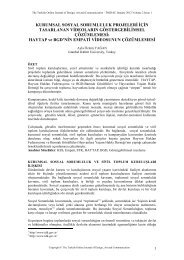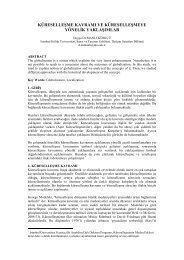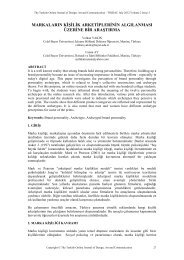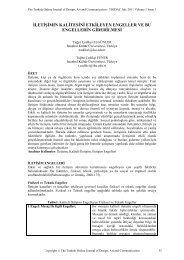aprıl 2012 - tojdac.org
aprıl 2012 - tojdac.org
aprıl 2012 - tojdac.org
Create successful ePaper yourself
Turn your PDF publications into a flip-book with our unique Google optimized e-Paper software.
The Turkish Online Journal of Design, Art and Communication - TOJDAC April <strong>2012</strong> Volume 2 Issue 2<br />
system and created the color-difference process. The Vlahos system was so successful that<br />
effects artists used the system for all the blue screen effects from the mid-1950s to the age of<br />
digital.[17]<br />
With the introduction of digital cinema and the ability to make the seperation digitaly it was<br />
just easier to composite the live action with either CGI or pre-shooted live background, yet<br />
The scene shooting can makes it either easy or painfull task for the compositer.<br />
It is the DP’s job to to design the blue/green shots lighting; this involves three main tasks:<br />
matching subject lighting with the background shot, making the screen very evenly lit and<br />
ensuring that neither area interferes with the other.<br />
The DP should fully understand certain procedures and apply them when preparing to the blue<br />
screen shot; The DP will have to:<br />
1- Consult with the post house, determine well in advance what components are eeded and<br />
resolve the order in which elements should be most efficiently and creatively shot.<br />
2- Coordinate the shooting of foregrounds and background to ensure that they will<br />
visually and photographically match.<br />
3- Document details of camera, lighting and scenic set-up for use by crew shooting the<br />
foreground elements.<br />
4- Match foreground camera and lighting to background data very precisely, with<br />
particular attention to perspective and direction of light.<br />
5- Choose keying colour, screen method and subject positioning carefully to maximize<br />
separation, evenness and thus quality of composite.<br />
6- Consider colour, texture and design of costumes and scenic elements in the foreground<br />
shoot to avoid technical problems.<br />
7- Provide full information to the post-production team detailing precisely what was done<br />
during the shoot.<br />
8- Do not degrade the foreground image by filtering or abnormal processing.[18]<br />
5. THE ROLE OF VFX DIRECTOR OF PHOTOGRAPHY<br />
After looking into some of the techniques involved in the making of the VFX scene and its<br />
development we reach the question: what is the VFX director of photography role<br />
The camera department consists of the director of photography (DP) and a crew of camera<br />
operators and camera assistants. The DP is in charge of all photography, including lighting<br />
and composition. The gaffer, head of the electrical department, works very closely with the<br />
DP on the lighting. Whatever is captured by the camera system (film or digital) will be used<br />
as the basis for the visual effects plates and will also be used as a look reference for any<br />
virtual shots. The DP should work with the VFX Supervisor, director, and production<br />
designer regarding the format and look desired since these will have a direct impact on the<br />
visual effects and post-production pipeline.<br />
With the use of previsualization (previs) – which is similar to the storyboard - in preproduction,<br />
some DPs are starting to rough-in lighting designs even at this stage. These<br />
designs provide them with a guide for lighting the real sets. This information will be useful in<br />
the post-production phase if the lighting design remains consistent. The VFX DP will pare in<br />
mind some of the issues include film format, capture media (film/digital), color correction,<br />
and special equipment requirements (repeatable heads, etc.). The overall look of the images<br />
and any required VFX shooting tests should also be discussed with the VFX producer. The<br />
VFX Director of Photography plays a major role in the art of visual storytelling. It is the VFX<br />
DP’s job to make all visual effects elements - be they background plates, miniatures, stunt<br />
doubles on a blue screen, aerial photography, or match the look of the 1st Unit DP’s<br />
photography so that all the elements will ultimately look like they have been photographed<br />
together.<br />
Copyright © The Turkish Online Journal of Design, Art and Communication 120









